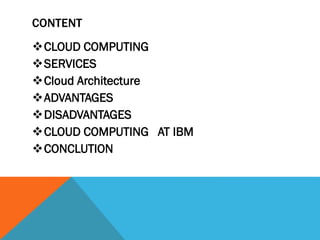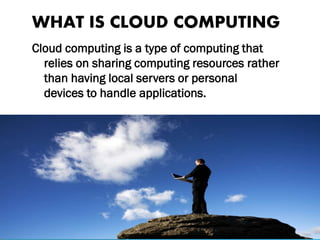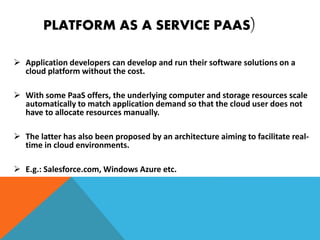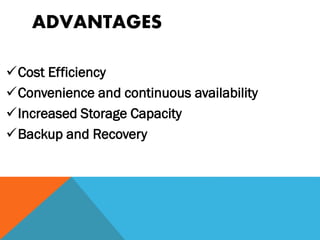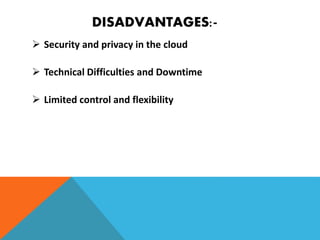Cloud computing
- 1. CLOUD COMPUTING BY:-Chhavi narayan Chiranjit Mallik C.Kavya D Sunil kumar Chandran S R Chandra sekhar reddy
- 2. CONTENT CLOUD COMPUTING SERVICES Cloud Architecture ADVANTAGES DISADVANTAGES CLOUD COMPUTING AT IBM CONCLUTION
- 3. WHAT IS CLOUD COMPUTING Cloud computing is a type of computing that relies on sharing computing resources rather than having local servers or personal devices to handle applications.
- 4. CLOUD COMPUTING SERVICES Software as a Service (SaaS)-End Users Infrastructure as a Service (IaaS)-Application Developers Platform as a Service (PaaS)- Network Architects
- 5. SOFTWARE AS A SERVICE-END USERS Is an application that can be accessed from anywhere on the world as long as you can have an computer with an Internet Connection. We can access this cloud hosted application without any additional hardware or software. E.g. : G-mail, Yahoo mail, Hotmail etc.., Also they can provide security features such as SSL encryption, a cryptographic protocol.
- 6. PLATFORM AS A SERVICE PAAS) Application developers can develop and run their software solutions on a cloud platform without the cost. With some PaaS offers, the underlying computer and storage resources scale automatically to match application demand so that the cloud user does not have to allocate resources manually. The latter has also been proposed by an architecture aiming to facilitate real- time in cloud environments. E.g.: Salesforce.com, Windows Azure etc.
- 7. INFRASTRUCTURE AS A SERVICE (IAAS) Also known as hardware as a service. Is a computing power that you can rent for a limited period of time. Allows existing applications to be run on a cloud suppliers hardware. Cloud providers offer computers – as physical or more often as virtual machines –, raw (block) storage, firewalls, load balancers, and networks
- 9. MODES OF CLOUDS Public Cloud • Computing infrastructure is hosted by cloud vendor at the vendors premises. • and can be shared by various organizations. • E.g. : Amazon, Google, Microsoft, Sales force Private Cloud • The computing infrastructure is dedicated to a particular organization and not shared with other organizations. • more expensive and more secure when compare to public cloud. • E.g. : HP data center, IBM, Sun, Oracle, 3tera Hybrid Cloud • Organizations may host critical applications on private clouds. • where as relatively less security concerns on public cloud. • usage of both public and private together is called hybrid cloud.
- 10. ADVANTAGES Cost Efficiency Convenience and continuous availability Increased Storage Capacity Backup and Recovery
- 11. DISADVANTAGES:- Security and privacy in the cloud Technical Difficulties and Downtime Limited control and flexibility
- 12. CLOUD COMPUTING AT IBM


